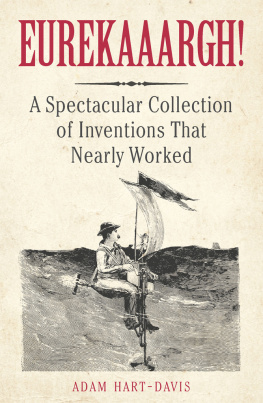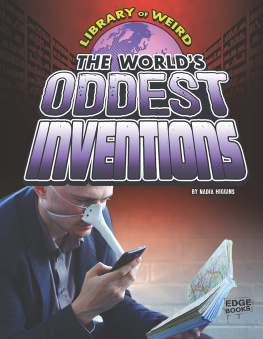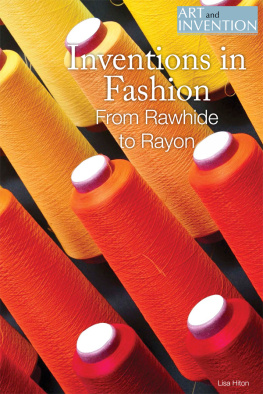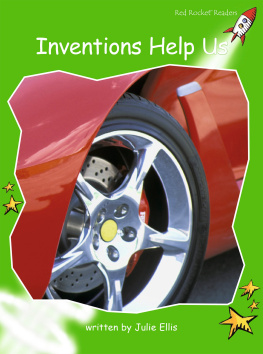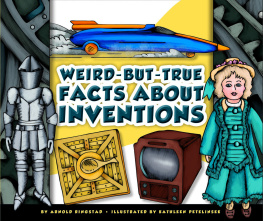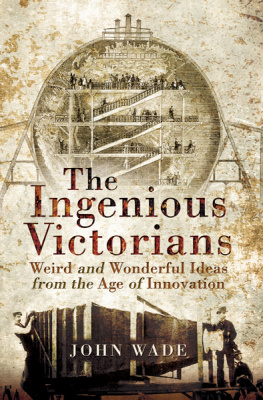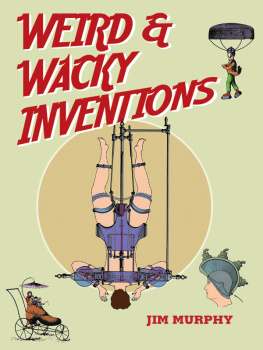

A CKNOWLEDGEMENTS
I am most grateful to Christine Foster, who spent many hours poring over dusty volumes in the glorious dungeons of the old Patent Office, and to Jolyon Troscianko, who drew a number of the pictures.
First published in Great Britain in 1999 by
Michael OMara Books Limited
9 Lion Yard
Tremadoc Road
London SW4 7NQ
This electronic edition published in 2013
Copyright 1999 Adam Hart-Davis
Every reasonable effort has been made to acknowledge all copyright holders. Any errors or omissions that may have occurred are inadvertent, and anyone with any copyright queries is invited to write to the publishers, so that a full acknowledgement may be included in subsequent editions of this work.
All rights reserved. You may not copy, store, distribute, transmit, reproduce or otherwise make available this publication (or any part of it) in any form, or by any means (electronic, digital, optical, mechanical, photocopying, recording or otherwise), without the prior written permission of the publisher. Any person who does any unauthorized act in relation to this publication may be liable to criminal prosecution and civil claims for damages.
The right of Adam Hart-Davis to be identified as the author of this work has been asserted by him in accordance with the Copyright, Designs and Patents Act, 1988.
A CIP catalogue record for this book is available from the British Library.
ISBN: 978-1-78243-102-2 in ePub format
ISBN: 978-1-78243-103-9 in Mobipocket format
ISBN: 978-1-85479-484-0 in hardback print format
Designed and typeset by Design 23
Cover image of Francois Barathons propeller-driven lifebuoy from Scientific American
www.mombooks.com
for Sue

Introduction
In 1879 the Rev. George William Garrett designed, built, and launched the worlds first powered submarine, which according to a newspaper report was very nearly successful. Unfortunately, very nearly successful is not quite good enough, especially for a submarine, and that is what this book is about.
Inventions are often at the leading edge of technology; enthusiastic engineers believe that it must be possible to build a submarine, a human-powered aircraft or a beautiful new musical instrument. They patent the idea, go ahead and build it, and sometimes it works, but sometimes it doesnt. Good iron and steel became available in the middle of the nineteenth century, along with good steam engines to provide power; the urge to build machines must have been almost irresistible, and that must be one reason why the Victorians seem to have been especially ingenious and diverse in their ideas. Creative engineers in the middle of the nineteenth century must have felt that any sort of machine they could imagine must be not only possible to build but unshakeably successful.
When I started working on this book I was worried that it might be just a list of unlucky duds and I kept feeling sorry for the person who invented the drink called 6-Up. However, the book seemed to take on a shape of its own, and I found that looking at the limits of possibility provided clues about why some inventions fell outside those limits. Sadly, I have only been able to scratch the surface of the subject; there are millions of failed inventions, and only a select few could get into a book of reasonable size.
I have generally avoided such pieces of technology as the telegraph or the Hansom cab, which were a great success in their day but have simply been superseded. Instead I have chosen particular areas of endeavour, such as flying and cycling, and within these areas have tried to show the great triumphs the inventions that actually worked, alongside a number of near and not-so-near misses. As you will see, many of these failed inventions were within inches of success indeed, some did succeed briefly; the steam carriage is a case in point, for steam carriages ran on our roads for a hundred years. Others, however, now seem so far from the possibility of working as to be absurd. However, we have the benefit of hindsight the only exact science.
Adam Hart-Davis
February 1999

Conquering the waves must have been a goal for millions of people, from swimmers and canoe-paddlers to those who designed the worlds greatest ships. But lurking for every swimmer and mariner are the desire to go more quickly, and the possibility of disaster
Swimming machines
Liborio Pedrazzolli was born and raised in Italy and moved to England about 1880. He married a local girl and set up a business at 11 Hoxton Street, London, making and selling mirrors, but he was also a keen swimmer.
I dont know whether he swam in the canal that runs through Hoxton, or in a swimming bath, but he must have been dissatisfied with the pull he was able to exert with his hands, for in 1896 he took out a patent for swimming umbrellas, to be held one in each hand, and the patent explains clearly how they were meant to work:
The apparati close when the hands are thrust forward thereby causing but little resistance or obstruction ... but when the return stroke is made the apparati expand in umbrella form, and the resistance thus offered enables the swimmer to pull or propel himself through the water at a speed hitherto impossible...
These umbrellas are not a disaster. They do open and give you a grip on the water. The problem is that they take about one foot of travel to open perhaps half a second. By this time your hand is back level with your shoulder, and most of the power of the stroke is gone used up in opening the umbrella. Meanwhile, every other movement is slightly impeded by holding the umbrellas, so that, although they probably speed you up a little at the end of the stroke, they slow you down all the rest of the time. Maybe I just did not make mine well enough. Perhaps you can do better.
More elaborate, and probably less efficient, is William A. Richardsons Improved Swimming Device of 1880. According to the inventor, transferring the work from the hands and feet to the propeller enables the swimmer to proceed rapidly and easily, at a speed of 46 m.p.h. Undaunted by this invention, Gustav Zacher patented in 1899 a closely similar machine with pedals for the feet to turn the propellers, and floats to take some of the weight of the apparatus. Mr Zacher claimed that the user could simultaneously swim and pedal:

Richardsons Improved Swimming Device (1880)
Thus a peculiar double action is produced firstly by the swimmer moving himself forward directly and taking the apparatus with him, and secondly by the propellers driving the apparatus forward and the latter carrying the swimmer along with it. In the consequence of this double action and the essentially greater utilisation of the leg power the swimmer can travel in the water with the apparatus much more quickly than the ordinary free swimmer, or than a person on a water vehicle propelled by him by a treadling motion and screw propellers.
Next page
